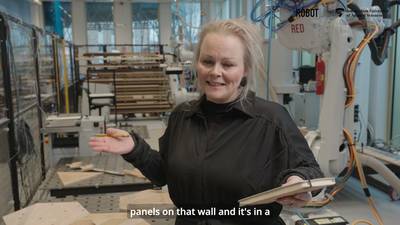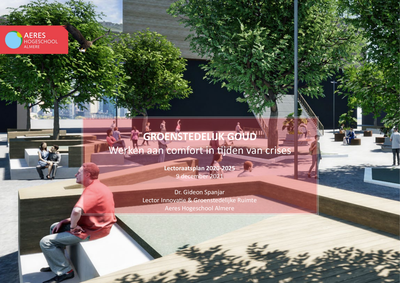How can a smart ‘upcycle wood factory’ (powered by industry 4.0 technologies and principles) help create meaningful and viable applications out of residual wood applicable to the hospitality sector?This video gives the answers.
YOUTUBE

Duurzaamheid is ‘in’ en leefbaarheid raakt een beetje ‘uit’. Wat betekent dit voor de wijkaanpak? Gaan we leefbare wijken nu verder ontwikkelen tot duurzame wijken? En kunnen we voor zo’n duurzame wijkontwikkeling ook iets leren van de jarenlange ervaring met het werken aan leefbaarheid? In dit artikel trekt Elly Straatman van Saxion Hogescholen lessen uit de aanpak van leefbaarheidsproblemen en geeft daar betekenis aan voor een duurzame wijkaanpak.
MULTIFILE
From a circular standpoint it is interesting to reuse as much as possible construction and demolition waste (CDW) into new building projects. In most cases CDW will not be directly reusable and will need to be processed and stored first. In order to turn this into a successful business case CDW will need to be reused on a large scale. In this paper we present the concept of a centralized and coordinated location in the City of Utrecht where construction and demolition waste is collected, sorted, worked, stored for reuse, or shipped elsewhere for further processing in renewed materials. This has expected advantages for the amount of material reuse, financial advantages for firms and clients, generating employability in the logistics and processing of materials, optimizing the transport and distribution of materials through the city, and thus the reduction of emissions and congestion. In the paper we explore the local facility of a Circular Hub, and the potential effects on circular reuse, and other effects within the City of Utrecht.
DOCUMENT

Confronted by more and more global sustainabilityrelated challenges, society is increasingly aiming for a circular economy. Wouldn’t it be ideal if we could contribute to an economic model with closed loops, where products and materials that are at the end of their functional life are reused in new products and systems? As the Netherlands aims to have a fully circular economy (i.e., zero net waste) by 2050, circularity is also a critical theme for the Amsterdam Metropolitan Area. ‘Circular City’ is one of the main urban challenges of the Urban Technology research programme of the Amsterdam University of Applied Sciences (AUAS). Its chair of Circular Design & Business and its research group on Digital Production collaborate with companies, lecturers and students on a range of applied research projects in order to advance the knowledge around circular design and business model strategies making use of digital production to encourage the local reuse of discarded urban materials. Amsterdam ArenA, home base of the Ajax football team and a major concert and events venue, is replacing all stadium seats in the run-up to the European Football Championship in 2020 (UEFA Euro 2020), and wishes to do so in a socially responsible manner. With that purpose, Amsterdam ArenA engaged the expertise of the Urban Technology research programme at the AUAS to study the viability reusing the old seats in a circular manner. The research started from the assumption that these discarded seats not only form a large and relatively homogeneous waste stream, but also have an emotional value that can potentially raise their economic value, beyond that of the material alone. For the AUAS this was an important case study, because the Amsterdam ArenA aspires to be a stage for sustainable innovations, reduce its environmental impact and stimulate the local economy. This project could serve as an example for other stadiums and public buildings with substantial waste streams on how to handle discarded products, and rethink how they can prevent waste in the future. With this mission, the AUAS lined up a team of experts on circular design, digital production, business modelling and impact studies to carry out a comprehensive multi-disciplinary study.
MULTIFILE
Het urban technology onderzoeksprogramma van de hogeschool van Amsterdam (HvA) doet onderzoek voor de omschakeling naar een circulaire stad. Een van de factoren die hierbij een rol spelen is hoe producten circulair ontworpen kunnen worden.
DOCUMENT
Van de achterflap: "Het is nú nodig om duurzaam te innoveren. De aarde vraagt er om. Maar ook vanwege economische redenen moeten we slimmer omgaan met grondstoffen en energie, ze worden steeds kostbaarder. Er is daarbij niet alleen sprake van een bedreiging, er liggen ook kansen. Het ontwikkelen van een circulaire economie zorgt namelijk voor nieuwe toegevoegde waarde. Om die kansen te kunnen benutten is het nodig om nú te beginnen. En dat kunnen bedrijven niet alleen. Samenwerken is onmisbaar en helpt om een toekomstbestendige industrie in Nederland neer te zetten – samen staan we sterk! Toch zien we dat het hieraan vaak ontbreekt. We roepen daarom op tot durven, delen en doen. En geven aanbevelingen om de industrie in Nederland ook in de toekomst sterk te houden. Al sinds haar oprichting in 1990 is Smart Group bezig met innovatie en duurzaamheid. Met hun creativiteit helpen de adviseurs van Smart Group bedrijven en organisaties met organisatorische, technische en marketinggerichte innovaties. Duurzaamheid is daarbij volgens Smart Group onontkoombaar. En daarbij gaan technologie, ontwikkelen van organisatie en mens, hand in hand."
LINK
We wonen in een land met het hoogste welvaartsniveau ter wereld en toch staat onze manier van leven onder druk. Hoe realiseren we uitnodigende en comfortabele steden in tijden van crisis? Het is voor mij eervol om als lector aan het roer te mogen staan van een lectoraat dat met de stad en regio samenwerkt om de meest urgente opgaven van de 21ste eeuw op te pakken. De gevolgen van klimaatverandering en grootschalig biodiversiteitsverlies zijn immers inmiddels voelbaar in ons leven.
DOCUMENT

Within European cities, entrepreneurs engage in private and public collaborative initiatives that work towards reducing local solid waste streams (Futurium, 2019). Furniture and interior design products account for nearly 50% of these waste streams, making them a key priority on the EU agenda to prevent climate change (Vanacore et al, 2021). New legislation to extend producer responsibility and reduce waste incineration is developing on a national level (PBL, 2021) and collaborative initiatives for urban upcycling are emerging (Ministerie I&W, 2023; Futurium, 2019). Business models to support upcycling are evolving, but their configuration and effectiveness is little understood.
DOCUMENT
With growing environmental concerns, upcycling has become an important theme in literature and practice. Upcycling can help slow and close resource cycles through product life-extension. Cities offer opportunities for upcycling initiatives and seek to tackle challenges in urban solid waste management by encouraging entrepreneurs to create value from local waste streams in urban resource centres and circular crafts centres. However, little is known about what drives urban upcycling and which barriers and drivers occur. This study explores urban upcycling in the context of the Dutch furniture industry, since The Netherlands positions itself as a ‘circular economy hotspot’ and furniture offers promising opportunities and best practices for upcycling. The analysis of 29 semi-structured interviews with experts engaged in urban upcycling reveals personal motives, drivers and barriers. Personal motives include (1) a personal purpose to ‘do good’, (2) an urge to challenge the status quo and (3) learning and inspiring by doing. Key drivers entail opportunities to (1) engage in collaborative experimentation, (2) participate in cross-sectoral local networks, (3) develop resource-based adaptive competences, (4) respond to increasing demand for upcycled products and (5) make social business activities financially viable. Key barriers perceived by upcycling experts include (1) limitations in resource availability, (2) increasing capacity requirements, (3) negative public quality perception, (4) limited marketing competences and (5) an unequal playing field. This study contributes with a comprehensive definition of urban upcycling and a structured overview of key factors that drive and constrain urban upcycling.
DOCUMENT
Upcycling has been embraced by circular economy enthusiasts, policy-makers and collaborative initiatives across Europe. Early studies describe upcycling as a concept aimed at resource conservation by keeping products, components and materials at their highest potential value across consecutive product lifecycles, with zero-negative or even potential positive impact on the natural environment. Similarly, more recent literature on the circular economy views upcycling as a strategy to slow and close resource cycles through product life-extension approaches, such as reuse, repair, refurbishment, remanufacturing and repurpose. With growing environmental concerns, upcycling has become a re-emerging theme in literature and practice. Cities offer opportunities for an increasing number of upcycling initiatives, but little is known about what manifestations of upcycling occur specifically in urban areas or how these urban upcycling initiatives emerge. For example, so-called Urban Resource Centers seek to tackle challenges in urban solid waste management by encouraging entrepreneurs to create value from local waste streams. Therefore, our objective is to address this literature gap and explore manifestations of upcycling in a city context by means of qualitative research, following a case-study approach based on data collected from research archives and 17 preliminary interviews with entrepreneurs and experts in urban upcycling of furniture and interior design products. This study contributes to a structured overview of urban upcycling initiatives and the internal and external factors that drive entrepreneurial initiatives and development. Future work will build on this study to make urban upcycling initiatives more widespread and impactful to deliver on their environmental and social goals.
MULTIFILE